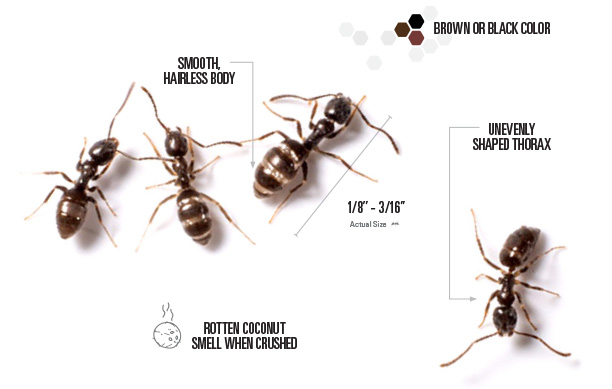Table Of Content

Harvester ant mounds can extend 2 meters or more underground. Colonies have a single queen and up to 12,000 workers who emerge during the day to forage for seeds, insects, and other foods. Harvester ants sting aggressively and can inflict multiple painful stings when disturbed. Carpenter ants nest in both dead and living wood, including tree limbs, stumps, logs, lumber, and structural timbers.
Food Habits

Argentine ants will readily share food and nesting spaces between separate colonies. Their lack of aggression toward each other gives them an advantage over other ant species when competing for resources. The most likely way to spot an infestation is to see the ants walking around.
What's Bugging You: How to Avoid Springtime Pests - Lancaster Farming
What's Bugging You: How to Avoid Springtime Pests.
Posted: Tue, 04 May 2021 07:00:00 GMT [source]
Signs of Odorous Ants
It cannot sting because it lacks a sting and will likely only bite if you stick a hand into its nest and vigorously disturb the colony. Occasionally winged reproductives found at lights concern residents too. Odorous house ant is common throughout the United States and is the second most common pest ant managed by professionals. Outdoors, odorous house ants place their shallow nests beneath soil as well as in logs, mulch, debris and under rocks. Odorous house ants can develop extremely large colonies but tend to maintain colonies of only several thousand workers with many queens.
How to Prevent an Infestation
The common signs of ants include; finding an ant trail in common areas of your apartment like the kitchen counters, window sills, or floors. You will also notice them if you’ve left out food and ants begin to crawl to it. If you live in a garden apartment, you might find small mounds of soil outside your apartment indicating an ant nest. In worse cases, if you find sawdust trails, your home may have carpenter ants that you’ll need to get rid of fast. They also are known to chew and damage electrical wires and insulation. Foraging trails along pipes, edges, and openings allow them to spread through buildings.
You’ll typically find him in his old fixer-upper, engrossed in a DIY project or trying out a new recipe. The same can’t be said of carpenter ants, which chew through rotten or damp wood, potentially damaging windows, doors, or even structural framing in the process. Keeping ants out of homes and buildings is an ongoing process, not a one-time treatment.
Pest Control
Pesky ants found in Hawaii demonstrate invasive characteristics - Purdue University
Pesky ants found in Hawaii demonstrate invasive characteristics.
Posted: Tue, 01 Nov 2011 07:00:00 GMT [source]
Lisa Jo Lupo is a pest control expert with over 25 years of experience in the pest control industry, writing about pest identification and management. Although relatively harmless, ants can quickly adapt to their environment and multiply. Too many ants can cause problems like food contamination and even structural damage. It’s best to look for signs of ants lingering in your apartment and prepare to get them out. If your efforts aren’t working to keep them away, contact your management so they can handle the situation with professional help. Think about it; ants are small enough to fit through the smallest of cracks in your building and, once inside, can weasel their way into any room.
Reasons to Move to San Marcos, CA, and Why You’ll Love Living There
A pest control operator can be hired to complete the treatments described. Monthly treatment for a year or more should not be necessary for control. Odorous house ant colonies inside the house can be treated with ready-to-use household insecticide sprays or dusts labeled for use against ants .
The scent, or pheromone trails, communicate to other ants where the food sources and nest are located. Erasing these trails prevents new ants from gathering in your home. A good DIY spray is a mix of 50/50 white vinegar and water in a spray bottle, shake, and spray it on ant trails and nearby spots where you saw the ants trailing. This ant is most likely to enter homes after heavy rains when it is attempting to escape the flooding of its shallow ground nest.
Notably, this species can form supercolonies, which consist of satellite colonies located close to the main colony. Control of odorous house ants should begin with an attempt to locate the origin of the ants. Careful and frequent observation may be necessary to develop an opinion about the source.
Identifying their presence, maintaining cleanliness, and using effective ant baits are crucial steps in controlling and preventing infestations. Odorous house ants are opportunists, nesting both indoors and outdoors. Odorous house ants like to eat sweets and are especially fond of honeydew. They are known to move their nests every three months or so in response to rain. Some sources advise against using baits inside because that can draw more ants into your home. However, if you have an infestation in the fall when it is cooler, you would be well advised to use indoor ant baits.
They’re not merely looking for a snack; they’re on a mission to uncover the secrets of your home, navigating its nooks and crannies with unmatched precision. NatureBlogNetwork.com is the leading birding research and information website. Keep wiping down those counters and stay vigilant against these resourceful little ants. Contact us today for a complimentary inspection and quote on ant extermination services. Craig & Sons Termite & Pest Control Inc serves the Riverside and San Bernardino county areas.


No comments:
Post a Comment